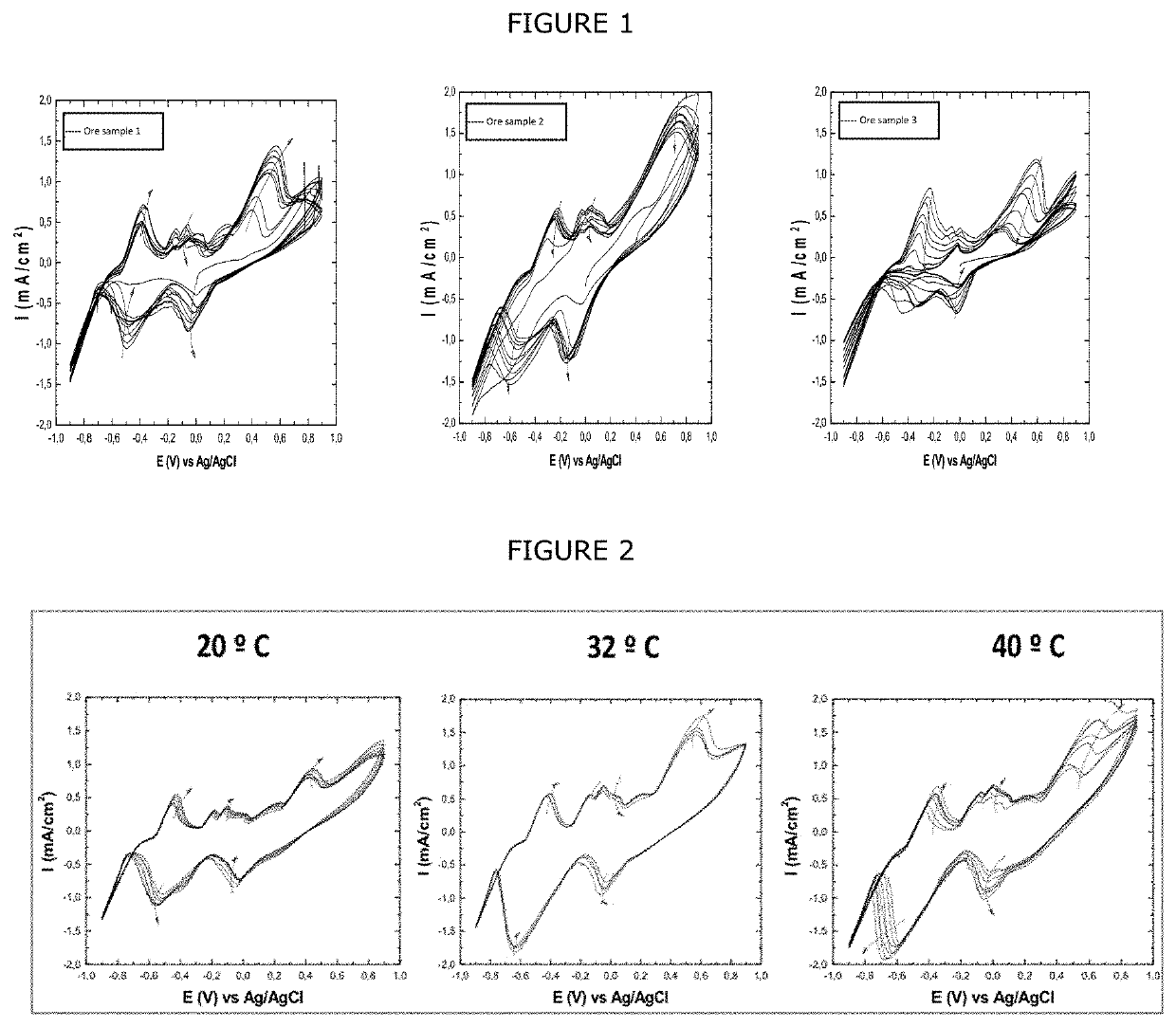Method for dissolving metallogenically primary copper metals obtained from ores and/or chalcopyrite concentrates that contain same
a technology of chalcopyrite concentrate and dissolving method, which is applied in the direction of process efficiency improvement, etc., can solve the problems of high reaction rate of heterogeneous reactions involving solid-gas and solid-solid phases at room temperature without the intervention of liquid phases
- Summary
- Abstract
- Description
- Claims
- Application Information
AI Technical Summary
Benefits of technology
Problems solved by technology
Method used
Image
Examples
working examples
Example 1: Obtaining Cyclic Voltammograms in Three Different Primary Minerals, Using Only Autocatalytic Dry Reductive Transformation
[0082]In order to visualize the REDOX phenomena which took place during the autocatalytic dry reductive transformation stage (Stage II), the cyclic voltammetric technique was used. This electrochemical technique consists of applying a cycle of voltages (millivolts) over time, where the potentiostat measures the current per unit area (mA / cm2). During this cycle, it presents a voltammetric curve that shows the interaction between the mineral (in the dropsen electrode) and the supersaturated leaching solution (electrolyte) by means of the different oxide-reduction processes that occur. For this purpose, three carbon paste dropsen electrodes were prepared with different chalcopyritic concentrates (mineral 1, mineral 2 and mineral 3) and mixed with graphite as the conductive medium. In addition, a solution of 9 g / L iron sulfate heptahydrate salts (FeSO4×7H2O...
example 2
Cyclic Voltamperograms with Mineral 1, in Terms of Temperature, Using Only the Autocatalytic Dry Reductive Transformation
[0085]In order to obtain the results shown in FIG. 2, the same conditions and parameters as the cyclic voltammograms of FIG. 1 were used, with the difference that only mineral 1 was used, which was subjected to three different temperatures 20, 32 and 40° C.
[0086]From FIG. 2, it can be seen how the increase in temperature for the same mineral has a smaller effect in the peaks generated in the anode and in the cathode, especially for temperatures of 32 and 40° C. This small difference achieved by increasing the temperature can be explained by the fact that the proposed technology obeys a reductive process, which is not totally dependent on temperature.
example 3
Cyclic Voltammograms in Three Different Primary Minerals, Including Reductive Activation and Autocatalytic Dry Reductive Transformation
[0087]In order to obtain the results shown in FIG. 3, the same conditions and parameters were used as for the autocatalytic dry reductive transformation, shown in FIG. 1, with the difference that the reductive activation stage was used for this test for 7 days, using a saturated solution of 50 g / L sodium chloride, 25 g / L ferrous sulfate and a 2M concentration of sulfuric acid. Once the 7 days of activation were completed, the cyclic voltammetry was carried out under autocatalytic dry reductive transformation conditions.
[0088]The results which derive from FIG. 3 show how the reductive activation stage on the three minerals has an activation effect, enhancing the phenomena in the anodic and cathodic zones, but mainly the process of reduction of chalcopyrite, significantly increasing the current per unit area.
[0089]The difference between the cathodic pe...
PUM
| Property | Measurement | Unit |
|---|---|---|
| time | aaaaa | aaaaa |
| concentrations | aaaaa | aaaaa |
| concentrations | aaaaa | aaaaa |
Abstract
Description
Claims
Application Information
 Login to View More
Login to View More - R&D
- Intellectual Property
- Life Sciences
- Materials
- Tech Scout
- Unparalleled Data Quality
- Higher Quality Content
- 60% Fewer Hallucinations
Browse by: Latest US Patents, China's latest patents, Technical Efficacy Thesaurus, Application Domain, Technology Topic, Popular Technical Reports.
© 2025 PatSnap. All rights reserved.Legal|Privacy policy|Modern Slavery Act Transparency Statement|Sitemap|About US| Contact US: help@patsnap.com



